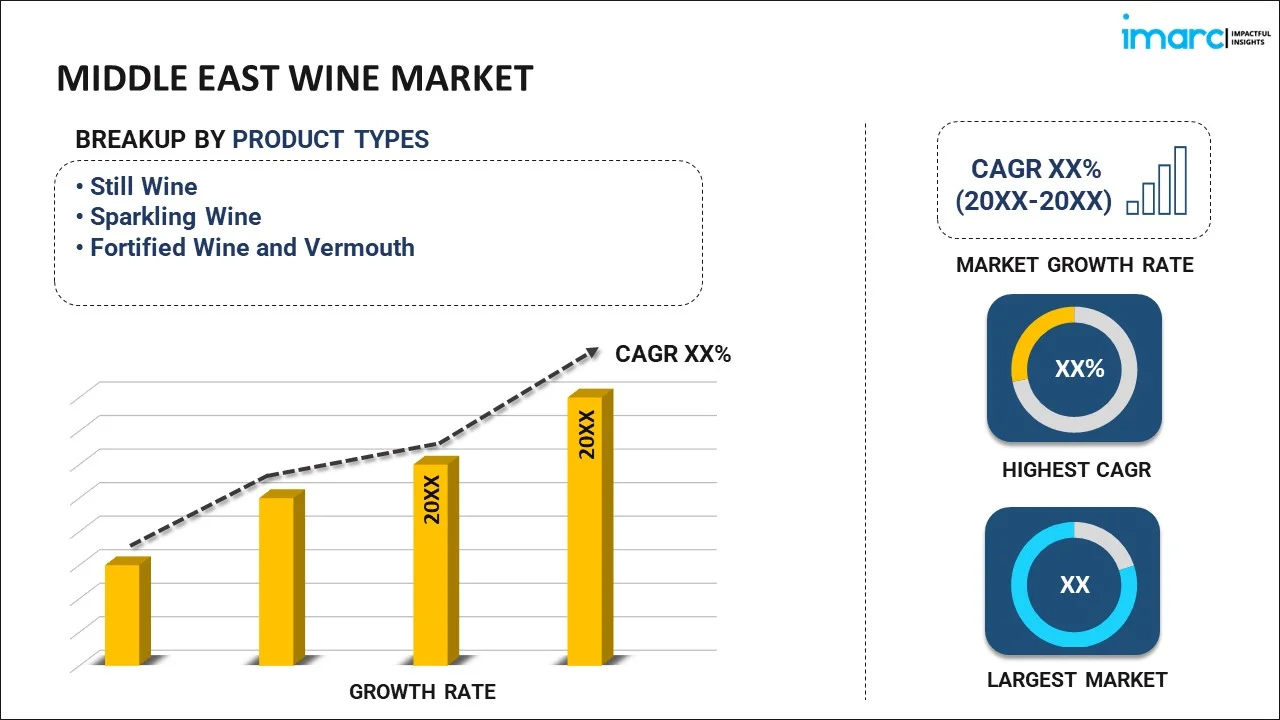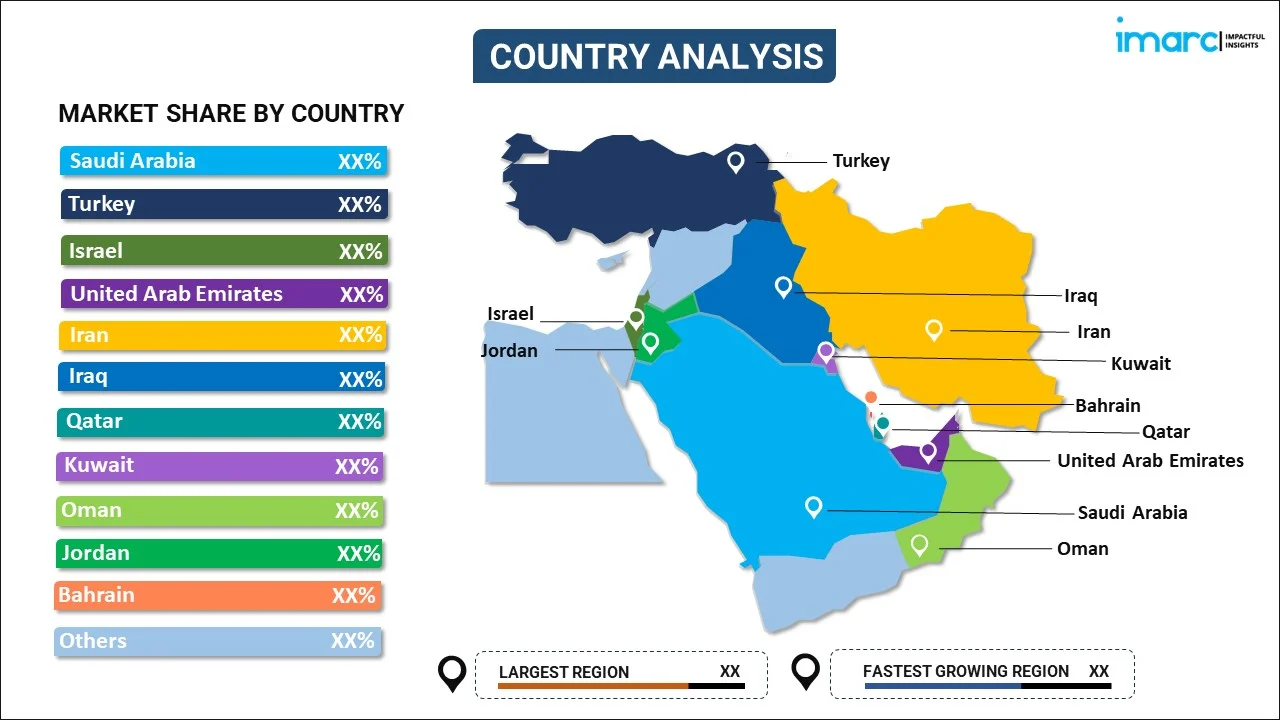
Middle East Wine Market Report by Product Type (Still Wine, Sparkling Wine, Fortified Wine and Vermouth), Color (Red Wine, Rose Wine, White Wine), Distribution Channel (Off-Trade, On-Trade), and Country 2026-2034
Market Overview:
Middle East wine market size reached USD 20.9 Billion in 2025. Looking forward, IMARC Group expects the market to reach USD 41.8 Billion by 2034, exhibiting a growth rate (CAGR) of 8.02% during 2026-2034. The growing number of wine festivals, tasting events, and educational programs are fostering a deeper understanding and appreciation for different grape varieties among consumers, which is primarily driving the market growth.
|
Report Attribute
|
Key Statistics
|
|---|---|
|
Base Year
|
2025
|
|
Forecast Years
|
2026-2034
|
|
Historical Years
|
2020-2025
|
|
Market Size in 2025
|
USD 20.9 Billion |
|
Market Forecast in 2034
|
USD 41.8 Billion |
| Market Growth Rate 2026-2034 | 8.02% |
Access the full market insights report Request Sample
Wine, an alcoholic beverage derived primarily from fermented grapes or various fruits, stands as one of the oldest drinks across the region. The fundamental winemaking process encompasses the fermentation of crushed grapes or fruit juice by yeast, leading to the conversion of sugars into alcohol and carbon dioxide. The extensive array of wines comprises red, white, rosé, and sparkling varieties, each distinguished by the specific grape type, winemaking methods, and the geographical origin of the grapes. This diversity contributes to the distinctive flavors and characteristics inherent in every type of wine, making it a beverage with unparalleled richness and complexity.
Middle East Wine Market Trends:
The Middle East wine market is experiencing noteworthy growth, influenced by several key drivers and emerging trends. One significant driver is the evolving cultural attitudes towards alcohol consumption in the region. As social norms shift, there is a growing acceptance and interest in wine, leading to an expanding consumer base. Additionally, another driving force is the increasing tourism in the Middle East, which have gained recognition for their burgeoning wine industries. Besides this, the rising number of international visitors has contributed to a heightened demand for local wines, creating opportunities for wineries in the region to showcase their products on a wide scale. Moreover, a prominent trend in the Middle East wine market is the emphasis on quality and innovation. Besides this, winemakers are adopting modern viticultural practices and investing in state-of-the-art technologies to enhance the quality of their wines. Furthermore, the Middle East is witnessing an increase in wine education and awareness. In conclusion, the Middle East wine market is undergoing positive transformations, driven by changing consumer attitudes, a rise in tourism, a focus on quality and innovation, and an increasing emphasis on wine education. As the region continues to carve its niche in the wine industry, these drivers and trends are anticipated to fuel the market growth in the coming years.
Middle East Wine Market Segmentation:
IMARC Group provides an analysis of the key trends in each segment of the market, along with forecasts at the regional and country levels for 2026-2034. Our report has categorized the market based on product type, color, and distribution channel.
Product Type Insights:

To get detailed segment analysis of this market Request Sample
- Still Wine
- Sparkling Wine
- Fortified Wine and Vermouth
The report has provided a detailed breakup and analysis of the market based on the product type. This includes still wine, sparkling wine, and fortified wine and vermouth.
Color Insights:
- Red Wine
- Rose Wine
- White Wine
A detailed breakup and analysis of the market based on the color have also been provided in the report. This includes red wine, rose wine, and white wine.
Distribution Channel Insights:
- Off-Trade
- Supermarkets and Hypermarkets
- Specialty Stores
- Online Stores
- Others
- On-Trade
The report has provided a detailed breakup and analysis of the market based on the distribution channel. This includes off-trade (supermarkets and hypermarkets, specialty stores, online stores, and others) and on-trade.
Country Insights:

To get detailed regional analysis of this market Request Sample
- Saudi Arabia
- Turkey
- Israel
- United Arab Emirates
- Iran
- Iraq
- Qatar
- Kuwait
- Oman
- Jordan
- Bahrain
- Others
The report has also provided a comprehensive analysis of all the major regional markets, which include Saudi Arabia, Turkey, Israel, United Arab Emirates, Iran, Iraq, Qatar, Kuwait, Oman, Jordan, Bahrain, and Others.
Competitive Landscape:
The market research report has also provided a comprehensive analysis of the competitive landscape in the market. Competitive analysis such as market structure, key player positioning, top winning strategies, competitive dashboard, and company evaluation quadrant has been covered in the report. Also, detailed profiles of all major companies have been provided.
Middle East Wine Market Report Coverage:
| Report Features | Details |
|---|---|
| Base Year of the Analysis | 2025 |
| Historical Period | 2020-2025 |
| Forecast Period | 2026-2034 |
| Units | Billion USD |
| Scope of the Report | Exploration of Historical Trends and Market Outlook, Industry Catalysts and Challenges, Segment-Wise Historical and Future Market Assessment:
|
| Product Types Covered | Still Wine, Sparkling Wine, Fortified Wine and Vermouth |
| Colors Covered | Red Wine, Rose Wine, White Wine |
| Distribution Channels Covered |
|
| Countries Covered | Saudi Arabia, Turkey, Israel, United Arab Emirates, Iran, Iraq, Qatar, Kuwait, Oman, Jordan, Bahrain, Others |
| Customization Scope | 10% Free Customization |
| Post-Sale Analyst Support | 10-12 Weeks |
| Delivery Format | PDF and Excel through Email (We can also provide the editable version of the report in PPT/Word format on special request) |
Key Questions Answered in This Report:
- How has the Middle East wine market performed so far and how will it perform in the coming years?
- What has been the impact of COVID-19 on the Middle east wine market?
- What is the breakup of the Middle East wine market on the basis of product type?
- What is the breakup of the Middle East wine market on the basis of color?
- What is the breakup of the Middle East wine market on the basis of distribution channel?
- What are the various stages in the value chain of the Middle East wine market?
- What are the key driving factors and challenges in the Middle East wine?
- What is the structure of the Middle East wine market and who are the key players?
- What is the degree of competition in the Middle East wine market?
Key Benefits for Stakeholders:
- IMARC’s industry report offers a comprehensive quantitative analysis of various market segments, historical and current market trends, market forecasts, and dynamics of the Middle East wine market from 2020-2034.
- The research report provides the latest information on the market drivers, challenges, and opportunities in the Middle East wine market.
- Porter's five forces analysis assist stakeholders in assessing the impact of new entrants, competitive rivalry, supplier power, buyer power, and the threat of substitution. It helps stakeholders to analyze the level of competition within the Middle East wine industry and its attractiveness.
- Competitive landscape allows stakeholders to understand their competitive environment and provides an insight into the current positions of key players in the market.
Need more help?
- Speak to our experienced analysts for insights on the current market scenarios.
- Include additional segments and countries to customize the report as per your requirement.
- Gain an unparalleled competitive advantage in your domain by understanding how to utilize the report and positively impacting your operations and revenue.
- For further assistance, please connect with our analysts.
 Request Customization
Request Customization
 Speak to an Analyst
Speak to an Analyst
 Request Brochure
Request Brochure
 Inquire Before Buying
Inquire Before Buying




.webp)




.webp)












